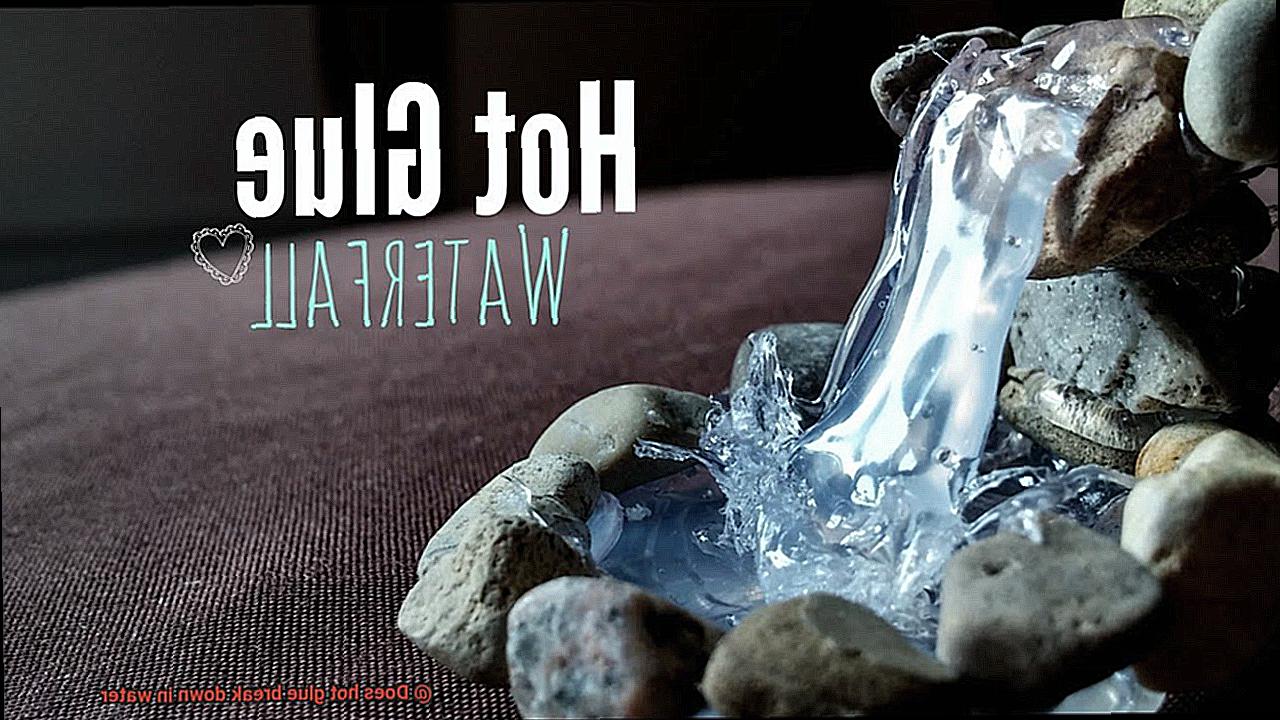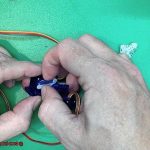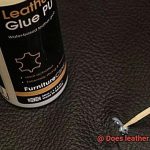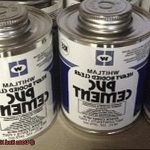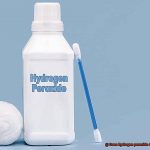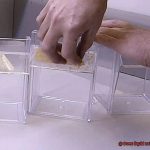Hot glue, the superhero of the crafting world. It’s quick, it’s sticky, and it holds our DIY dreams together. But what happens when hot glue meets its arch-nemesis: water? Does it stand strong like a fearless warrior or crumble like a soggy cookie? Buckle up, my crafty comrades, because we’re about to dive deep into the mysterious world of hot glue and its relationship with H2O.
Picture this: you’re at a craft fair, showcasing your masterpiece. Suddenly, rain starts pouring down like cats and dogs. Panic sets in as you wonder if your hot glue creations will survive this watery onslaught. Fear not. We’re here to uncover the science behind the effects of water on hot glue so you can be prepared for any unexpected aquatic encounters.
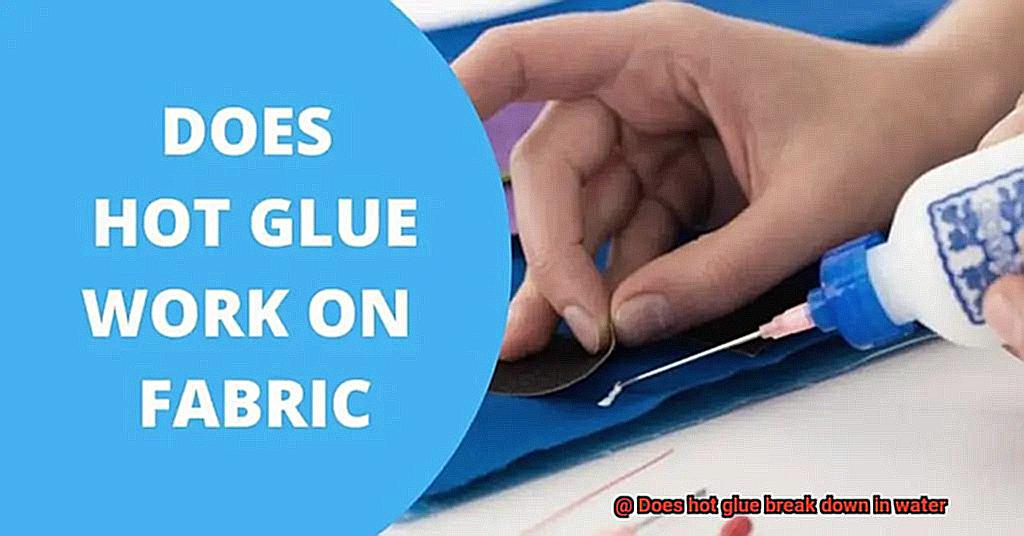
Hot glue is made up of special polymers that transform from solid to liquid when heated. This magical metamorphosis allows it to flow smoothly and create a bond that would make even superheroes jealous. But when water crashes the party, things get interesting.
The main ingredient in hot glue is a blend of thermoplastic polymers like ethylene vinyl acetate (EVA) or thermoplastic polyurethane (TPU). These polymers are hydrophobic – they repel water like an umbrella repels raindrops. So initially, when water meets hot glue, it might seem like they could be BFFs forever.
But hold your glue guns. While hot glue may not dissolve completely in water, it’s not invincible either. Water can sneak into tiny nooks and crannies in the adhesive’s surface, weakening its grip over time. Think of it as an undercover agent infiltrating the secret hideout of your craft project.
And let’s not forget about humidity. High humidity levels can turn our trusty sidekick into a squishy mess. The moisture in the air seeps into the thermoplastic polymers, making them soft and less effective at creating a strong bond. It’s like hot glue’s kryptonite.
So, what does all this mean for your crafty endeavors? Well, if you’re planning on using hot glue for something that might get wet or exposed to moisture, it’s time to reconsider. Hot glue can handle a little splash here and there, but it’s not built for long-term water resistance.
What is Hot Glue?
Contents
- 1 What is Hot Glue?
- 2 Properties of Hot Glue
- 3 Does Hot Glue Break Down in Water?
- 4 Factors that Affect the Breakdown of Hot Glue in Water
- 5 Types of Hot Glue Formulations and Their Resistance to Water
- 6 Temperature and Its Effect on Hot Glue’s Reaction to Water
- 7 Alternatives to Hot Glue for Moisture Resistance Applications
- 8 Conclusion
Hot glue, also known as hot melt adhesive or glue sticks, is a game-changer in the world of crafts, DIY projects, and industrial applications. But what exactly is it?
At its core, hot glue is made up of synthetic polymers that are solid at room temperature but transform into a molten liquid when exposed to heat. Derived mainly from petroleum-based sources like ethylene or propylene, hot glue can also be made from eco-friendly alternatives sourced from renewable resources.
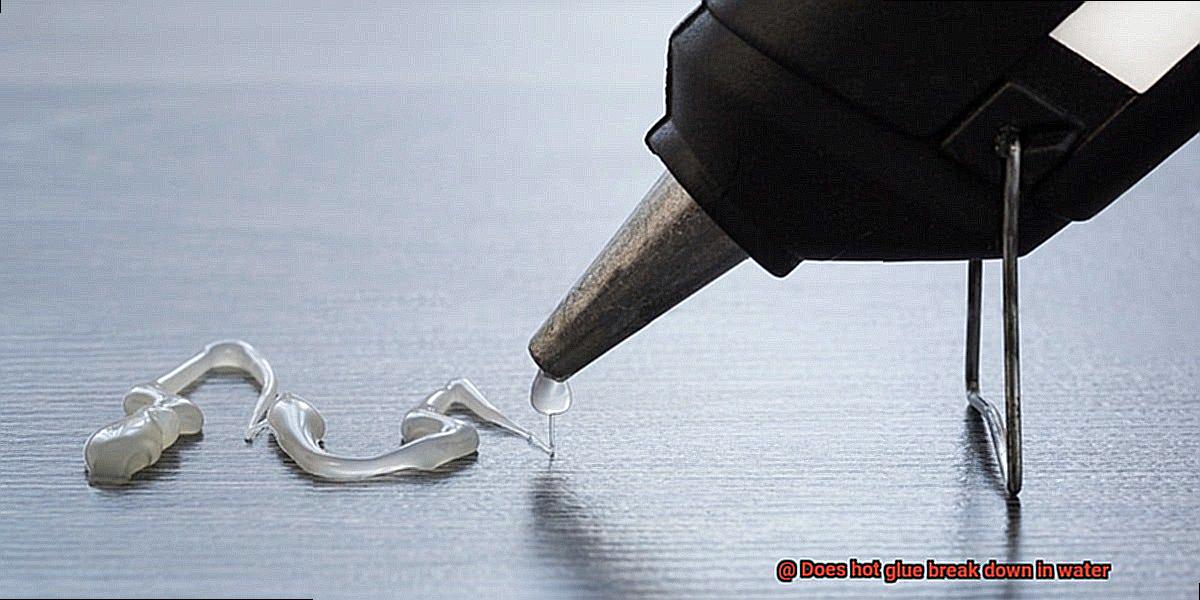
To put hot glue to work, it is loaded into a glue gun and heated until it reaches a melting point. Once it becomes a liquid, it is dispensed through the gun’s nozzle onto the desired surface. The beauty of hot glue lies in its low viscosity when melted, allowing it to flow smoothly and effortlessly into small gaps and crevices.
But the magic of hot glue doesn’t stop there. Its exceptional adhesion properties make it a champion at bonding materials together. Whether you’re working with plastics, ceramics, metal, or glass, hot glue forms a strong bond that can withstand both heat and moisture. This makes it perfect for high-temperature environments and outdoor applications.
To cater to different project requirements, hot glue is available in various formulations with different melting points and set times. Some are designed for general use, while others are specialized for specific materials or applications.
Properties of Hot Glue
Hot glue, also known as hot melt adhesive, is a versatile adhesive that is widely used in crafting and DIY projects. Its unique properties make it the go-to choice for many enthusiasts. Let’s explore the remarkable properties of hot glue in detail.
Firstly, hot glue sets quickly, allowing for immediate bonding. Within seconds of being applied, it solidifies, creating a strong and reliable bond. This makes it perfect for projects that require instant adhesion, such as attaching decorations to surfaces or securing objects together.
Secondly, hot glue is incredibly versatile. It adheres well to a wide range of surfaces including wood, fabric, plastic, metal, and even glass. Whether you’re working on a woodworking project or creating a fabric masterpiece, hot glue will bond with precision and strength.
Furthermore, hot glue offers flexibility once it has dried. It retains a degree of elasticity, enabling it to withstand minor movements or vibrations without cracking or breaking. This flexibility is particularly useful for applications where the bonded objects may experience stress or movement over time.
Another impressive property of hot glue is its heat resistance. Once cooled and solidified, hot glue can withstand moderate temperatures without melting or losing its adhesive strength. This makes it an excellent choice for projects that involve heat exposure, such as attaching embellishments onto clothing that may undergo ironing.
However, it’s important to note that hot glue is not waterproof. When exposed to water or high humidity over time, hot glue can soften or lose its bonding strength. Therefore, it’s not recommended for applications where it will be regularly exposed to moisture.
Does Hot Glue Break Down in Water?
Hot glue is crafted from thermoplastic polymers. These polymers are solid at room temperature but become molten when heated. The result is a liquid adhesive that can be easily applied to various surfaces. Thermoplastics possess a unique quality—they soften and melt when exposed to heat.
Now, water is no match for hot glue. Water typically exists at a much lower temperature than the melting point of hot glue. That means when hot glue meets water, it remains steadfast, holding its structure and properties intact. In simple terms, hot glue doesn’t break down or dissolve when submerged in water.
However, while hot glue may not crumble in water, it could experience a dip in adhesive strength when faced with moisture. Water has a sneaky way of seeping into the porous structure of the glue, weakening its bond with the surface it clings to. This becomes especially true when glued items are perpetually exposed to water or excessive humidity.
To ensure a long-lasting union with hot glue in wet conditions, it’s wise to opt for a waterproof variant or apply a protective coating over the glued area. Additionally, using a higher temperature setting on the hot glue gun during application can create a mightier bond resistant to moisture.
Factors that Affect the Breakdown of Hot Glue in Water
The breakdown of hot glue in water is influenced by several key factors. Firstly, temperature plays a significant role. Higher temperatures can weaken the adhesive properties of hot glue, making it more susceptible to breakdown in water. Conversely, lower temperatures slow down the breakdown process.
Exposure time is another important factor. The longer hot glue is exposed to water, the more likely it is to deteriorate. The exact duration required for complete breakdown varies depending on factors such as glue composition and thickness.
Glue composition also affects the breakdown of hot glue in water. Different types of hot glue have varying resistance to water. Some are designed to be water-resistant or waterproof, meaning they are less prone to breaking down in water. Others may contain additives that promote easier breakdown in water for specific applications.
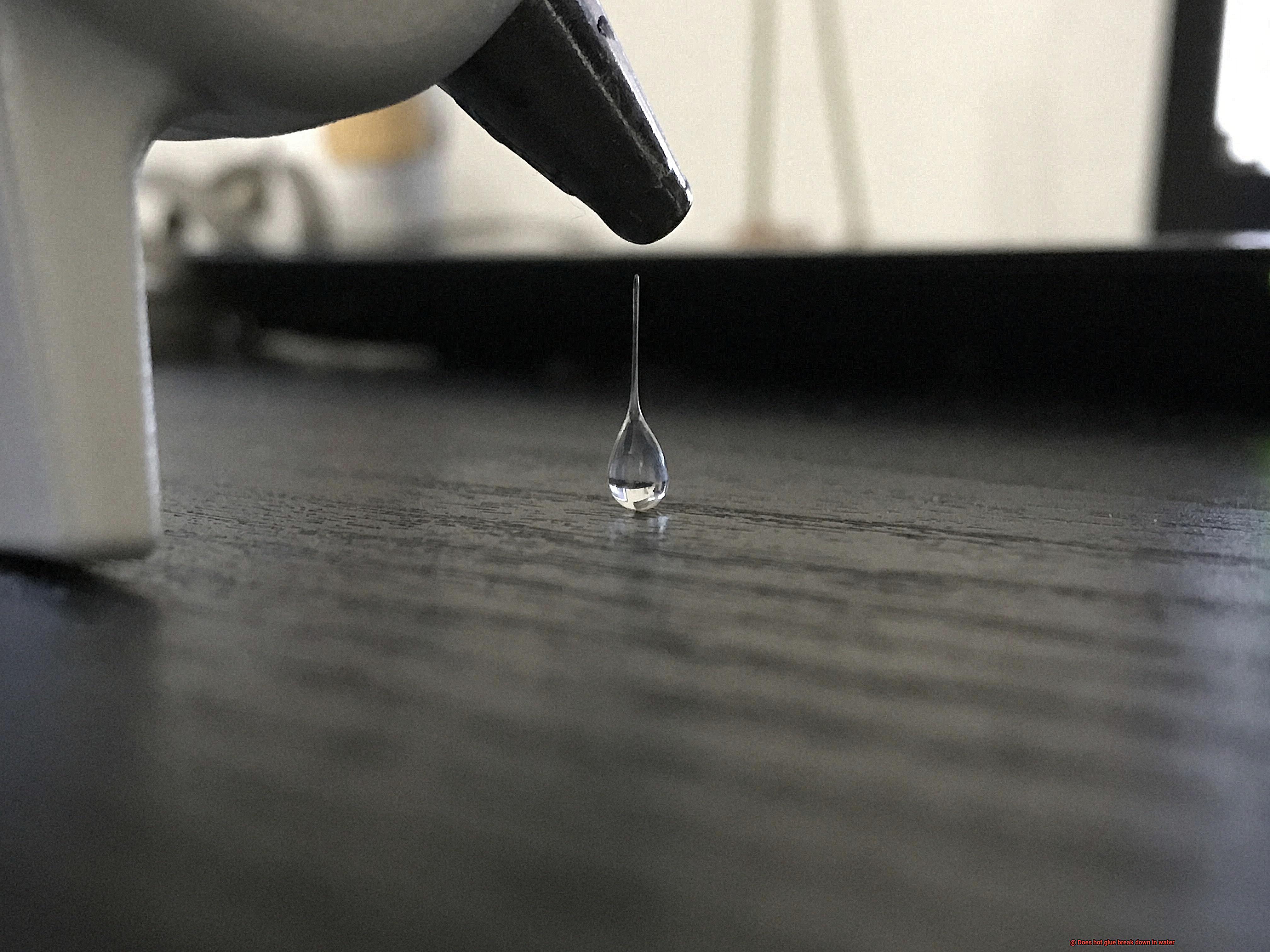
Water pH can potentially react with the components of hot glue and lead to faster degradation. Highly acidic or alkaline water has a greater effect on hot glue’s integrity compared to water with a neutral pH (around 7).
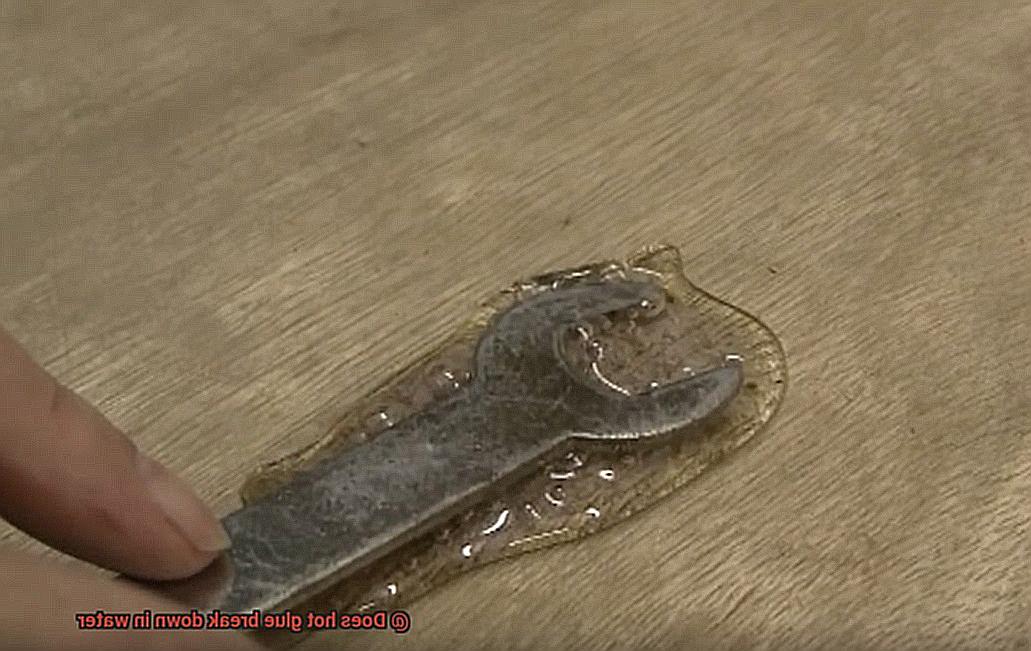
The surface texture on which hot glue is applied also plays a role. Smooth surfaces provide less opportunity for water penetration, allowing hot glue to maintain its adhesive properties for longer periods. In contrast, rough or porous surfaces facilitate water absorption, leading to quicker breakdown.
Mechanical stress, such as pulling or twisting, can accelerate the breakdown of hot glue in water. When exposed to both water and physical force simultaneously, the adhesive bonds weaken and eventually break apart more easily.
Lastly, humidity levels can indirectly impact the breakdown of hot glue in water. High humidity increases moisture content in the air, potentially leading to quicker water absorption by hot glue and subsequent breakdown. Low humidity may slow down the breakdown process due to reduced moisture availability.
Types of Hot Glue Formulations and Their Resistance to Water
Standard Hot Glue Formulation
Standard hot glue is a commonly used adhesive for crafts and simple repairs. Made from synthetic polymers and resins, it offers moderate resistance to water. However, prolonged exposure to moisture can weaken its bond, potentially causing projects to fall apart. Therefore, it is not advisable to use standard hot glue in water-prone areas or projects that may encounter excessive moisture.
High-Temperature Hot Glue Formulation
Designed to withstand higher temperatures and provide stronger bonds, high-temperature hot glue offers better resistance to water than the standard version. Although it can still degrade over time when exposed to excessive moisture, it is more reliable in wet or humid conditions. While high-temperature hot glue is not entirely waterproof, it provides enhanced water resistance compared to standard hot glue.
Water-Resistant Hot Glue Formulation
For projects that require a strong bond in wet or humid conditions, water-resistant hot glue formulations are the ideal choice. These glues contain additives or special ingredients that make them more resistant to water and moisture. They are commonly used for outdoor crafts or repairs where exposure to water is inevitable. When choosing hot glue for water-prone areas or projects, it is essential to select a formulation explicitly labeled as water-resistant.
Varying Levels of Water Resistance
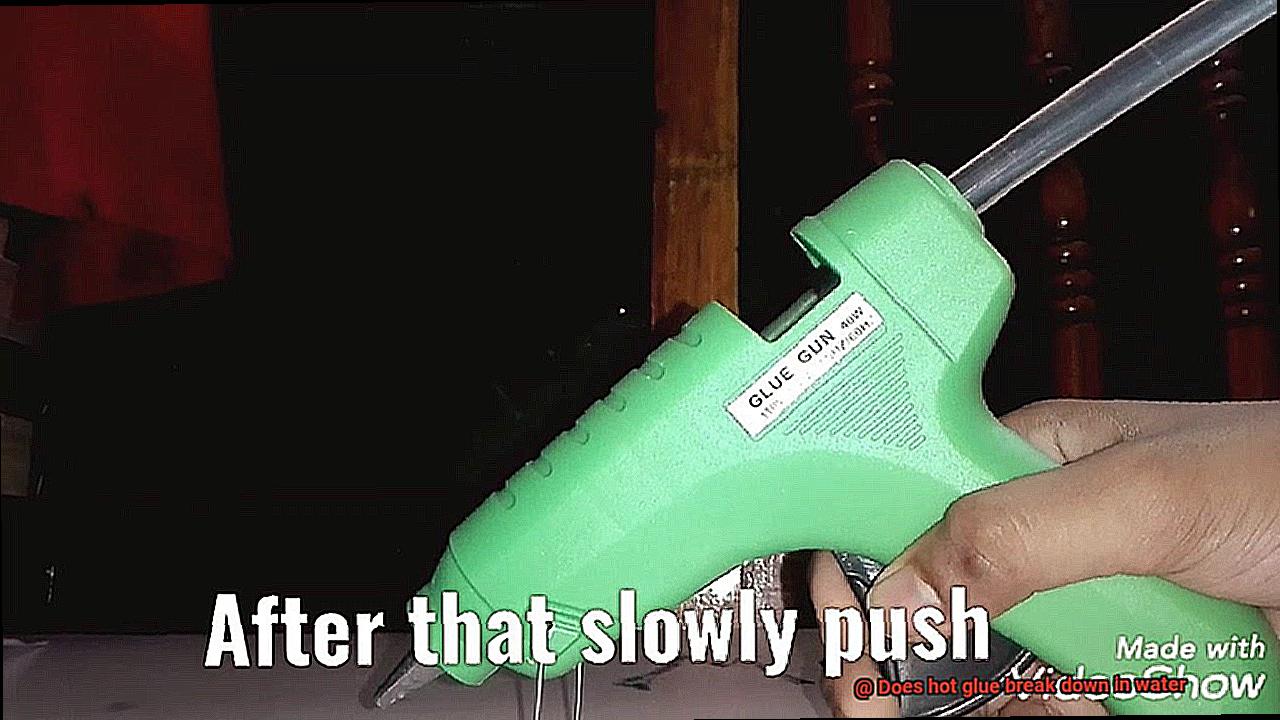
Water resistance can vary among different brands and formulations of hot glue. The specific ingredients and manufacturing processes used play a significant role in determining the level of resistance offered by each formulation. To ensure the best results, it is crucial to read product labels and descriptions carefully, allowing you to choose the most suitable hot glue for your specific application.
Other Factors Affecting Water Resistance
In addition to the hot glue formulation itself, other factors can influence its resistance to water. The surface on which the glue is applied, the amount of pressure it undergoes, and the duration of exposure to water all impact the adhesive’s water resistance. By properly preparing the surface and applying the hot glue using recommended techniques, you can enhance its overall resistance to water.
No Guarantees of Complete Water Immunity
It is essential to note that even with the most water-resistant hot glue formulations, complete immunity to water damage is not guaranteed. Prolonged exposure or immersion in water can eventually break down even the most resistant hot glue bonds. Therefore, it is crucial to consider the specific requirements of your project and choose the appropriate adhesive accordingly.
Temperature and Its Effect on Hot Glue’s Reaction to Water
Temperature is a key factor that determines how hot glue reacts when it encounters water. At room temperature or lower, hot glue displays a remarkable similarity to oil, forming droplets or beads on the water’s surface. This behavior arises from the low affinity that hot glue generally possesses for water at these temperatures. In other words, it does not easily absorb or dissolve in water.
However, the story changes when hot glue is heated to higher temperatures before coming into contact with water. The increased temperature causes the hot glue to become more fluid and less viscous, enabling it to mix and disperse more readily in the water. This process, known as emulsification, results in the formation of an emulsion where tiny droplets or particles of hot glue intermix with the water.
It is important to note that even though hot glue can emulsify in water at higher temperatures, it does not dissolve completely. The solid components of the hot glue remain intact but are dispersed within the water.
The temperature at which emulsification occurs can differ depending on the specific type and brand of hot glue being used. Different formulations of hot glue have distinct melting points and may react differently to water at various temperatures.
Understanding how temperature affects the reaction of hot glue to water is crucial when selecting the appropriate adhesive for applications involving water exposure. For instance, if a hot glue bond is exposed to high temperatures followed by contact with water, emulsification may weaken or cause it to break apart more easily. On the contrary, if cold-hot glue encounters water, the beads or droplets formed on the water’s surface act as a protective barrier against water infiltration, bolstering the bond.
While hot glue offers moderate resistance to water, extended exposure to moisture can weaken it and lead to project failure. Consequently, it may not be suitable for areas or projects prone to water exposure. However, certain high-temperature and water-resistant hot glue formulations are available that offer enhanced resistance to water damage, although full immunity cannot be guaranteed.
Alternatives to Hot Glue for Moisture Resistance Applications
While hot glue is versatile and dries quickly, it may not be the best choice for projects exposed to water or moisture. Let’s explore some alternatives that will meet your needs head-on.
- Epoxy Adhesive: Picture this – a two-part adhesive that combines a resin and hardener to create an unyielding bond resistant to water and moisture. That’s epoxy adhesive for you. Whether you’re fixing leaks or bonding materials that will be exposed to water, epoxy is your go-to option. It comes in various formulations, including those designed explicitly for underwater applications.
- Silicone Adhesive: Seeking the crème de la crème of water resistance? Silicone adhesive is your answer. It boasts exceptional waterproof properties and can be used on a wide range of materials like plastics, glass, metal, and ceramics. From bathroom renovations to kitchen projects, silicone adhesives reign supreme where moisture exposure is high. Plus, they come in different viscosities and cure times, ensuring you find the perfect fit for your specific needs.
- Polyurethane Adhesive: When you demand the utmost moisture resistance, polyurethane adhesive delivers. Forming a flexible and waterproof bond, it withstands exposure to water, chemicals, and even UV rays. The construction and automotive industries swear by polyurethane adhesives for their durability and resilience under harsh conditions.
Now that we’ve explored these alternatives, let’s consider some factors when choosing the right one for your project:
- Materials being bonded: Different adhesives work better on specific materials. Take into account the compatibility between the adhesive and the materials you’re working with to ensure a robust bond.
- Level of moisture exposure: Assess the amount of water or moisture your project will encounter. Certain adhesives perform exceptionally well in wet environments, so choose one that aligns with your project’s needs.
- Desired strength of the bond: Depending on the application, you may require a strong or flexible bond. Consider the adhesive’s properties and select one that aligns with your desired outcome.
- Drying time and application method: Keep in mind that different adhesives have varying drying times and application methods. Follow the manufacturer’s instructions meticulously for optimal results.
Remember to prepare and clean surfaces thoroughly before bonding, regardless of which alternative adhesive you choose. This step maximizes adhesion and ensures long-lasting results.
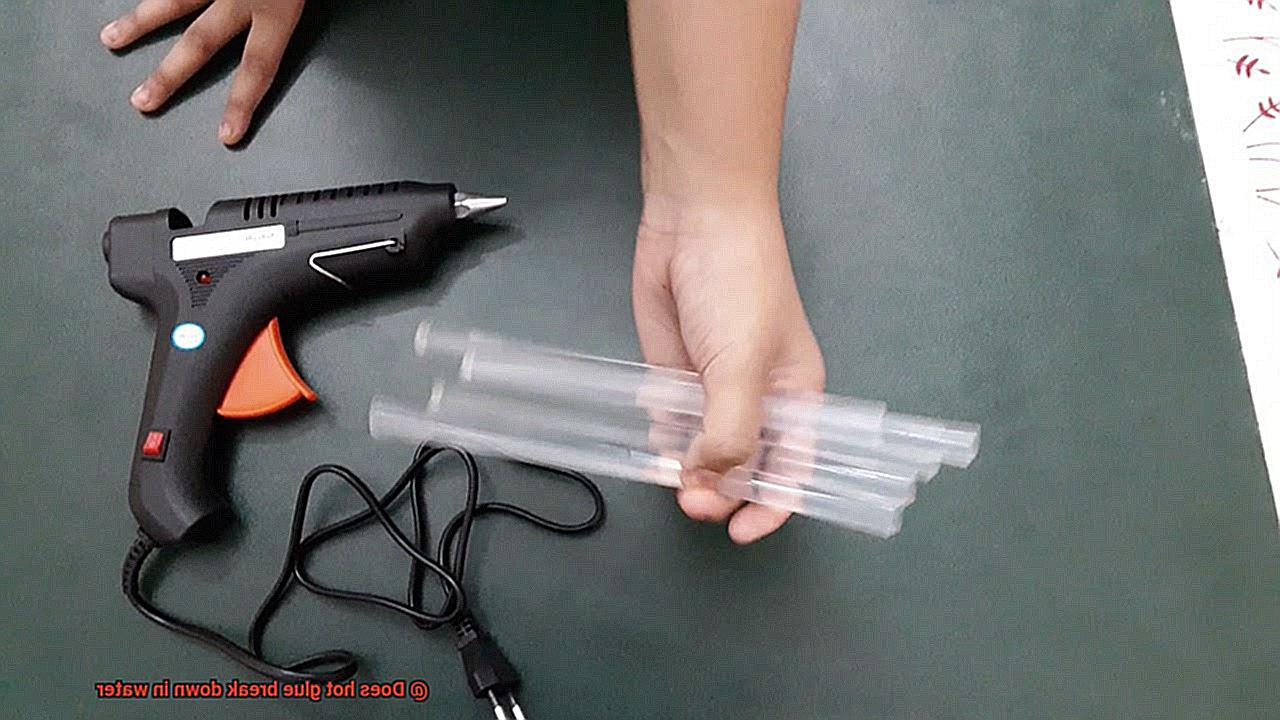
So, if you’re tackling a project that demands moisture resistance, explore alternatives like epoxy, silicone, or polyurethane adhesives. And don’t forget, mechanical fasteners like screws or nails can also be fantastic options.
Conclusion
In conclusion, hot glue is not impervious to water. Although it is made of hydrophobic polymers that repel water, over time, water can seep into its microscopic crevices, weakening its hold. Moreover, hot glue becomes less effective in humid conditions as it softens and loses its strength.
So, if you’re thinking of using hot glue for something that might come into contact with water or moisture, think again. While it can handle occasional splashes, it lacks the long-term water resistance necessary for such situations.
But don’t despair. There are ways to safeguard your hot glue creations against water damage. You can opt for a waterproof variant of hot glue or apply a protective coating to bolster its moisture resistance.
Alternatively, if you require an adhesive with superior water resistance, there are alternatives at your disposal. Epoxy adhesive forms an unyielding bond that withstands water and moisture effortlessly. Silicone adhesive boasts exceptional waterproof properties and is ideal for projects exposed to high levels of moisture. Polyurethane adhesive offers flexibility and durability even in harsh conditions.

